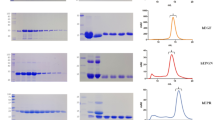Abstract
Human epidermal growth factor 1-48 (hEGF 1-48, Des(49-53)hEGF) is a single chain polypeptide (48 amino acids; 3 disulfide bonds; 5445 Da) possessing a broad spectrum of biologic activity including the stimulation of cell proliferation and tissue growth. In this study, three primary aqueous degradation products of hEGF 1-48 were isolated using isocratic, reverse phase/ion-pair HPLC. The degradation products were characterized using amino acid sequencing, electrospray ionization mass spectrometry, isoelectric focusing, and degradation kinetics. Results indicate that hEGF 1-48 degrades via oxidation (Met21), deamidation (Asn1), and succinimide formation (Asp11). The relative contribution of each degradation pathway to the overall stability of hEGF 1-48 changes as a function of solution pH and storage condition. Succinimide formation at Asp11 is favored at pH < 6 in which aspartic acid is present mostly in its protonated form. Deamidation of Asn1 is favored at pH > 6. The relative contribution of Met21 oxidation is increased with decreasing temperature, storage as a frozen solution (−20°C), and exposure to fluorescent light.
Similar content being viewed by others
REFERENCES
M. C. Manning, K. Patel, and R. T. Borchardt. Stability of protein pharmaceuticals. J. Pharm. Res. 6(11):903–918 (1989).
R. Pearlman and T. Nguyen. Pharmaceutics of protein drugs. J. Pharm. Pharmacol. 44(Suppl. 1):178–185 (1992).
R. D. Schmid. Stabilized soluble enzymes. Adv. Biochem. Eng. 12:41–118 (1979).
G. Carpenter and S. Cohen. Epidermal Growth Factor. Ann. Rev. Biochemistry 48:193–216 (1979).
C. M. Stoscheck and L. E. Knig, Jr. Role of epidermal growth factor in carcinogenesis. Cancer Res. 46:1030–1037 (1986).
W. H. Moolenaar. Effects of growth factors on intracellular pH regulation. Ann. Rev. Physiol. 48:363–376 (1986).
R. V. Nardi, A. Guglietta, and I. Parikh. Epidermal growth factor. In S. Benjamin and M. Collen (eds.), Pharmacology of Peptic Ulcer Disease (Handbook of Exp. Pharmacol. Ser., Vol. 99), Spr-Verlag, 1991, pp. 37–53.
M. J. O'Hara and E. C. Nice. Hydrophobic high-performance liquid chromatography of hormonal polypeptides and proteins on alkylsilane-bonded silica. J. Chromatogr. 185:413–427 (1979).
I. H Lee, S. Pollack, S. H. Hsu, and J. R. Miksic. Influence of the Mobile Phase on Salmon Calcitonin Analysis by Reversed-Phase Liquid Chromatography. J. Chrom. Sci. 29:136–140 (1991).
Y. M. Torchinsky, W. Wittenberg, and D. Metzler. Sulfur in Proteins, Pergamon Press, New York, 1981.
C. George-Nascimento, A. Gyenes, S. M. Halloran, J. Merryweather, P. Valenzuela, K. S. Steimer, F. R. Masiarz, and A. Randolph. Characterization of recombinant human epidermal growth factor produced in yeast. Biochemistry, 27(2):797–802, 1988.
J. K. Cini, C. L. Ace, J. Spaltro, and C. George-Naccimento. Photooxidation of Recombinant Human Epidermal Growth Factor. FASEB J., 6(4):1350 (1992).
M. Hartmanis and A. Engstrom. Occurrence of methionine sulfoxide during production of recombinant human insulin-like growth factor I (IGF-I). In T. E. Hugli (ed.), Techniques in Protein Chemistry, Acad Pr., 1989, pp. 327–333.
D. G. Smyth, W. H. Stein, and S. Moore. On the sequence of residues 11 to 18 in bovine pancreatic ribonuclease. J. Biol. Chem., 237(6):1845–1850 (1962).
R. P. DiAugustine, B. W. Gibson, W. Aberth, M. Kelly, C. M. Ferrua, Y. Tomooka, C. F. Brown, and M. Walker. Evidence for isoaspartyl (deamidated) forms of mouse epidermal growth factor. Anal. Biochem. 165:420–429 (1987).
C. George-Nascimento, J. Lowenson, M. Borissenko, M. Calderon, A. Medina-Selby, J. Kuo, C. Clarke, and A. Randolph. Replacement of a labile aspartyl residue increases the stability of human epidermal growth factor. Biochemistry, 29:9584–9591 (1990).
B. N. Violand, M. R. Schlittler, E. W. Kolodziej, P. C. Toren, M. A. Cabonce, N. R. Siegel, K. L. Duffin, J. F. Zobel, C. E. Smith, and J. S. Tou. Isolation and characterization of porcine somatotropin containing a succinimide residue in place of aspartate129. Protein Science, 1(12):1634–1641 (1992).
S. Clarke, R. C. Stephenson, and J. D. Lowenson. Lability of asparagine and aspartic acid residues in proteins and peptides. In T. J. Ahern and M. C. Manning (eds.), Stability of Protein Pharmaceuticals, Part A: Chemical and Physical Pathways of Protein Degradation (Pharm. Biotech. Ser., Vol. 2), Plenum Press, New York, 1992, pp. 1–29.
E. Sondheimer and R. W. Holley. Imides from asparagine and glutamine. J. Am. Chem. Soc. 76:2476–2470 (1954).
J. Bongers, E. P. Heimer, T. Lambros, Y. E. Pan, R. M Campbell, and A. M. Felix. Degradation of aspartic acid and asparagine residues in human growth hormone-releasing factor. Int. J. Peptide Protein Res. 39:364–374 (1992).
S. Capasso, L. Mazzarella, F. Sica, A. Zagari, and S. Salvadori. Kinetics and mechanism of succinimide ring formation in the deamidation process of asparagine residues. J. Chem. Soc. Perkin. Trans. 2:679–682 (1993).
R. C. Stephenson and S. Clarke. Succinimide formation from aspartyl and asparaginyl peptides as a model for the spontaneous degradation of proteins. J. Biol. Chem. 264(11):6164–6170 (1989).
Y. Shalitin and S. A. Bernhard. Cooperative effects of functional groups in peptides. II. Elimination reaction in aspartyl-(O-acyl)-serine derivatives. J. Am. Chem. Soc. 88:4711–4721 (1966).
N. P. Neumann. Methods in Enzymology, v.25b., Academ. Press, New York, p. 393, 1972.
N. P. Neumann. Methods in Enzymology, v.11., Academ. Press, New York, p. 485, 1967.
G. Toennies and T. P. Callan. Methionine studies III. A comparison of oxidative reactions of methionine, cysteine, and cystine. Determination of methionine by hydrogen peroxide oxidation. J. Biol. Chem. 129:481–490 (1939).
R. N. Chilamkurti. Formulation development of frozen parenteral dosage forms. J. Parenter. Sci. Technol. 46(4):124–129 (1992).
S. S. Larsen. Studies on stability of drugs in frozen solutions. Arch. Pharm. Chem. Sci. 1:541–568 (1973).
S. Schwimmer. Source Book of Food Enzymology, Avi Publishing, Westport, CN, 1981.
O. Fennema. Activity of enzymes in partially frozen aqueous systems. In R. B. Duckworth (ed.), Water Relations of Foods, Academic Press, New York, 1975.
Author information
Authors and Affiliations
Rights and permissions
About this article
Cite this article
Senderoff, R.I., Wootton, S.C., Boctor, A.M. et al. Aqueous Stability of Human Epidermal Growth Factor 1-48. Pharm Res 11, 1712–1720 (1994). https://doi.org/10.1023/A:1018903014204
Issue Date:
DOI: https://doi.org/10.1023/A:1018903014204




